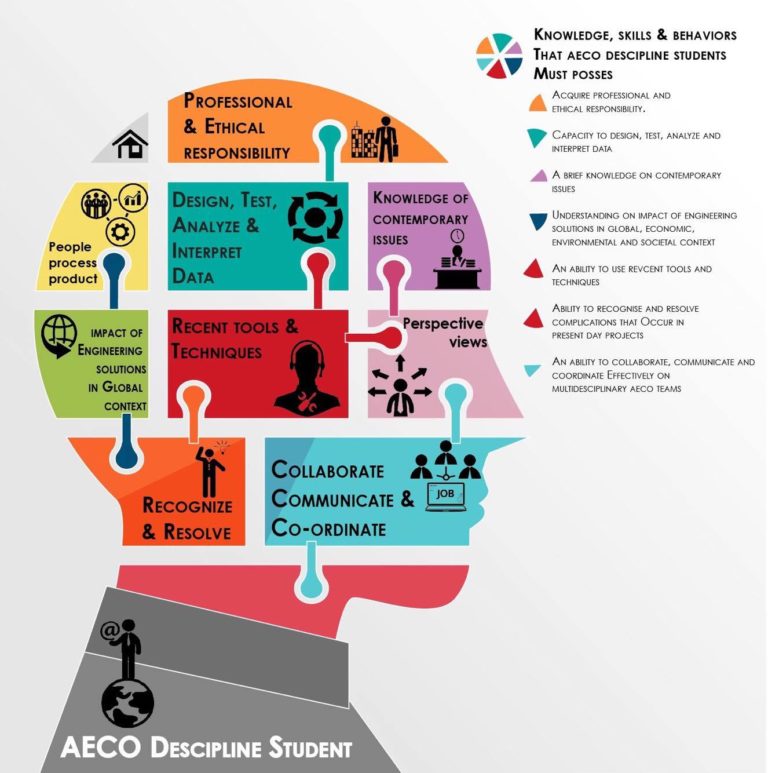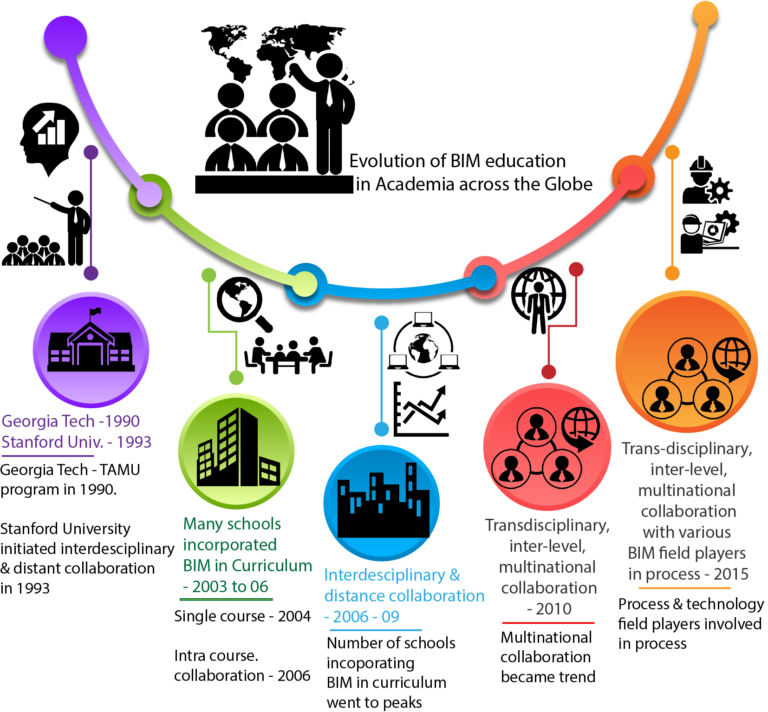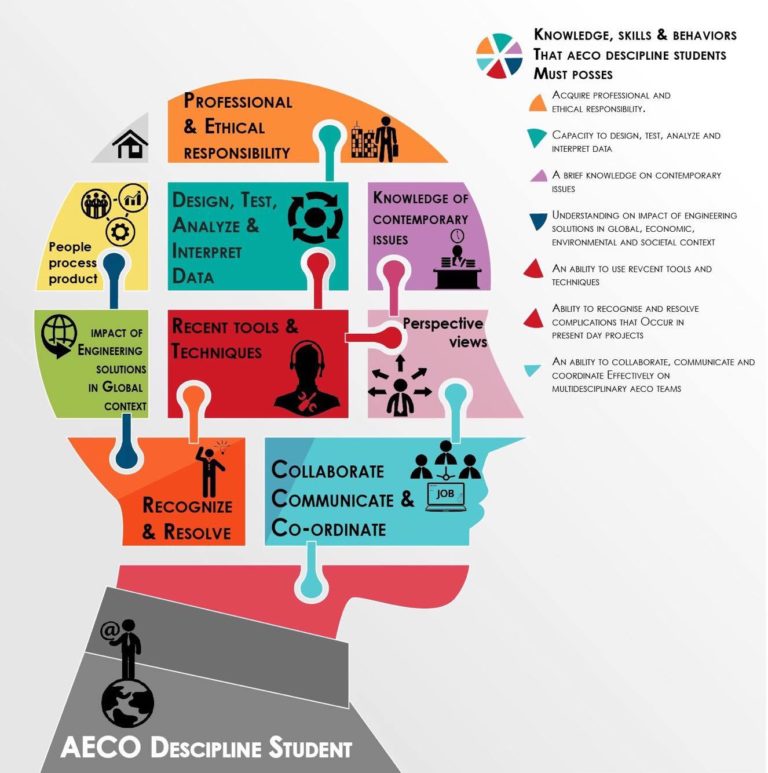The BIM Knowledge, Skills & Behaviors that AECO Discipline Students Must Possess

AECO industry is inclined towards employing graduates with exposure to BIM tools, techniques and processes. In line with today’s AECO industry necessities, universities are running a wide range of BIM courses, for exposing AECO students to this new paradigm shift. However, today’s academic BIM education is not completely integrated with other AECO programs in Tertiary Education System (TES). BIM education in academia has a history of almost two and half (2.5) decades.
The development of BIM teaching in universities from 1990s to date can be visualized as in Figure 1. Georgia Institute of technology in USA has carried out research in BIM i.e. TAMU project since the early 90s. Also, their architecture programs were those first showed interest in this area. In line, Stanford University in 1993 integrated BIM into curriculum by introducing interdisciplinary and distant collaboration for their discipline students.

Figure 1: Evolution of BIM education in academia
Here, students worked in geographically distributed multi-disciplinary teams to learn about cross-disciplinary impacts, integration issues, usage of collaboration technologies, team dynamics, collaborative work, and the impact of collaboration technologies on organization performance. Witnessing the benefits of BIM technology and processes for AECO industry, several universities globally had incorporated BIM to their curriculum by 2003. Around 2004, teaching the students on BIM concepts, tools and techniques was seen as an important part of AECO programs. And, BIM education was delivered for students as a single course in majority of the universities. Approaching to the year 2006, few universities made an effort to experiment for delivering BIM education with intra-course collaboration by integrating AECO discipline students. Reflecting the benefits of intra course, from the year 2006-09, several universities started introducing BIM course in their curriculum with collaboration types such as distance and interdisciplinary. By the year 2010, inter-level, trans-disciplinary and multinational collaboration had become the trend for BIM course delivery (Barison & Santos 2012b). However, most of the universities had introduced BIM education in only one subject-area and few attempts to stimulate the integrated practices.
Besides these programs, Project Based Learning (PBL) lab established by Dr. Renate Fruchter at Stanford University is a pilot model to demonstrate on how construction educators might teach and enable students to practice team collaboration in a global framework (Becker et al. 2011). BIM Academic Forum (BAF), a group of representatives from a large number of UK Universities and BIM task group, was established in late 2011. BAF was established to respond for AEC industry’s BIM adoption and to promote the academic aspects of BIM in the UK. To fulfill the optimum requirements for BIM teaching among Higher Education Institutions (HEIs) in the UK, a BIM assessment matrix was also developed by BAF (Underwood & Ayoade 2015). The UK has stepped ahead in promoting BIM education in most of the Universities at UK, thereby benefiting all adopters i.e. HEIs, students and AECO industry. Recently, Gier (2015) has also evidenced that BIM education is trending towards trans-disciplinary, inter-level and multinational collaboration with process and technology field players, considering that students need to collaborate with actual industry professionals on real cases.
Research analysis on global trends in BIM education by reviewing the BIM publications reveals that, BIM is not just an addition to the original AEC curriculum, but as a catalyst enabling education reform for AECO associated disciplines. Academia demands for the revision of old AEC curriculum to cope up with industry needs. Project based learning and Computer-Medicated Communications (CMC) combined together can support this paradigm shift. And, several universities have realized that, BIM should be thought as a tool/technique and process to produce BIM-ready graduates (Barison & Santos 2012b). Another key question for AECO specialty educationalists and researchers is how to design courses in which BIM technology enriches teaching rather than substitutes for it?
Efforts have already been undertaken by active BIM academicians/educationalists in Brazil and Australia to assist students and professionals on specialized BIM skill sets (Gardner et al. 2014; Barison & Santos 2010a, 2011, 2012a, 2013). In our standpoint, future AECO discipline students need to be trained with these new skills and technological competencies to address the upcoming challenges. Dossick et al. 2015 and Hsieh et al. 2015 study reveals that BIM education in academia benefits AECO discipline students to gain BIM knowledge by adopting latest practice such as trans-disciplinary, inter level and multinational collaboration with AECO industry professionals and academia. Above discussed innovative practices in universities support the delivery of quality BIM education in TES.
Different AECO industry specialists need distinct BIM knowledge and skill sets. AECO students, who will be future BIM specialists, need to be trained to acquire such essential competencies. Here, the term BIM specialist refers to any of BIM modelers, BIM analysts, BIM application/software developers, BIM managers/coordinators, BIM consultants, and BIM researchers. BIM educationalists train these future specialists with the unique BIM skill sets required by adopting certain training techniques. The basic skill sets that AECO discipline students must possess are identified in our study and it is visualized in Figure 2. To start with, students must be able to visualize AECO projects with different views and perspectives. Second, students should acquire professional and ethical responsibilities. Third, students must be capable to design, test, analyze and interpret data. Fourth, they must acquire a brief knowledge on contemporary issues, e.g. climate change. Fifth, students need to understand on impact of engineering solutions in global, economic, environmental and societal context. Sixth, students must have an ability to use recent AECO industry tools and techniques to successfully accomplish real project case. Seventh, students must be able to recognize and resolve complications that occur in present day projects. Eight, is that students must be capable enough to Collaboration, Communication, Coordination (CCC) effectively on multidisciplinary AECO teams and projects. And last but not least, students must be able to understand the relationships between people, products and processes.

Figure 2: Knowledge, skills and behaviors that AECO discipline students need to possess
Along with this basic knowledge, skills and behaviors stated above, AECO students must possess distinct BIM knowledge and skill sets to be a BIM ready graduate as stated in this section. BIM knowledge and skill sets such as, technical (modeling, drafting, and model management), operational (designing, simulating, and quantifying), functional (collaboration, facilitation, and project management), implementation (component development, standardization, and technical training), administrative (tendering and procurement, contract management, and human resource management), support (data and network support, equipment, and software troubleshooting), managerial (leadership, strategic planning, and organizational management), and R&D, i.e. change management, knowledge engineering, and industry engagement (Succar & Sher, 2013; Amarnath et al. 2016). BIM educationalists train these future BIM graduates with the unique BIM skill sets required by adopting certain training techniques. `BIM-ready’ graduates with the knowledge base, skill sets and behaviors outlined above will be suitable for today’s AECO industry to effectively deliver projects.












